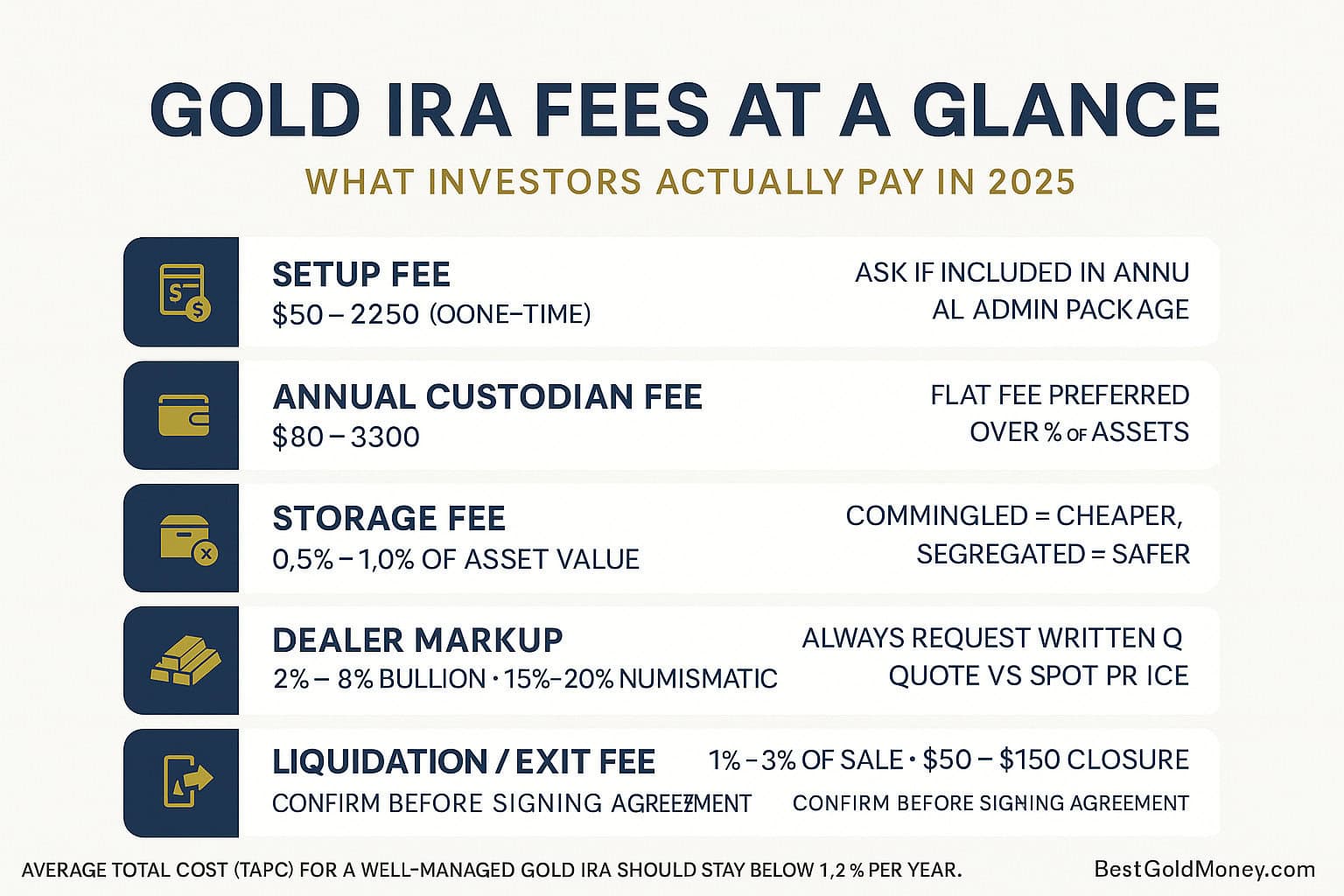How to Reduce Gold IRA Fees

Investing in a Gold IRA can strengthen your retirement portfolio by adding a layer of protection against inflation and market volatility. However, managing the account efficiently requires more than simply buying gold: it means understanding exactly how much you’re paying, and what you’re paying for.
Contrary to traditional investment accounts, Gold IRAs involve multiple parties: a custodian to manage compliance, a depository to store your metals, and a dealer to handle transactions. Each introduces its own fees: some of them are transparent, others are buried and hidden. Over time, these can quietly reduce your net returns if left unchecked.
The key isn’t just to find the lowest-cost provider, but to recognize which fees are reasonable for the service provided and which are unnecessary. In this guide, you’ll learn how to interpret custodian fee structures, compare providers effectively, and identify hidden costs before they erode your investment.

Key Takeaways:
- Gold IRA fees vary widely depending on the custodian, storage option, and dealer markup—understanding each category is essential before opening an account.
- Typical annual costs range from 0.5% to 1.2% of total assets, but hidden or layered fees can push that number higher if not monitored.
- Transparency beats low pricing. A slightly higher fee with clear disclosure is often safer than a low-cost provider with hidden charges.
- Most fees are negotiable, especially dealer premiums and annual administration costs—compare at least three providers before committing.
- Knowledge equals savings. The more you understand how Gold IRA fees work, the more control you have over your long-term investment returns.
Importance of Understanding Gold IRA Fees
Understanding how Gold IRA fees work is essential for anyone considering precious metals as part of their retirement plan. These fees directly influence your long-term returns, and even small differences in cost can add up to thousands of dollars over time.
A Gold IRA, or Individual Retirement Account backed by physical metals, requires the involvement of third parties such as custodians, depositories, and dealers. Each of these entities provides a service, but also charges for it. Because the chain of responsibility is longer than in a traditional IRA, hidden or indirect fees can easily appear along the way. Without proper oversight, these costs can quietly erode your profits.
The structure of Gold IRA fees is often more complex than it seems. Investors sometimes focus only on the upfront setup cost while overlooking recurring maintenance, storage, or transaction fees charged by custodians. This misunderstanding leads to frustration later, when unexpected charges appear on annual statements.
Taking the time to understand these fees is not optional; it is a prerequisite for success. The more informed you are, the better positioned you’ll be to negotiate fair terms, compare providers objectively, and maintain control over your investment. Awareness of how each fee operates empowers you to spot red flags, avoid overpaying, and ultimately protect your retirement savings.
Types of Gold IRA Fees
Gold IRA fees can broadly be categorized into several types, each serving a specific purpose in the management of your precious metals' investment.
The primary categories include setup fees, annual maintenance fees, transaction fees, and storage fees. Each of these fees plays a vital role in the overall administration of your Gold IRA and can vary significantly based on the provider you choose.
Gold IRA Custodian Fees Explained
Setup fees
These are one-time charges applied when you first open your account. They cover paperwork, compliance checks, and account creation. Depending on the custodian, setup fees can range from a couple of hundred dollars to over a thousand. Some providers waive them entirely if your initial investment is large enough, so it’s worth asking before you sign.Annual maintenance fees
This is the yearly cost of keeping your Gold IRA active. It usually covers record-keeping, statements, and account management. While the industry average falls between $100 and $300, some custodians offer lower rates for larger accounts or bundled services. Comparing different providers here can save you significant money over time.Transaction fees
Every time you buy or sell precious metals within your IRA, you may be charged either a flat fee or a percentage of the transaction. If you plan to trade frequently, these fees can eat into your returns quickly. Look for custodians that offer flat, transparent pricing—or consider a long-term buy-and-hold approach to reduce costs.
Tip: Always ask for a full fee schedule before committing to a custodian. Transparency is key, and a clear breakdown will help you avoid hidden charges that erode your investment.
List of Custodian Fees
The setup fee
One-time charge incurred when you open your Gold IRA account
Annual maintenance fees
Recurring fees for ongoing account management and reporting
Transaction fees
Charged whenever you buy or sell precious metals within your IRA.
Gold Dealer Costs: How to Keep Them Low
Beyond custodian fees, investors also need to factor in the costs charged by gold dealers. Dealers add a premium over the spot price of gold, which covers their operating expenses and profit margin. This premium is unavoidable, but how much you pay depends on the dealer you choose.
- Premiums vary by product
Coins, bullion bars, and specialty items often carry different premiums. Comparing prices across multiple dealers ensures you’re not overpaying. For larger purchases, ask about bulk discounts; many reputable dealers are willing to lower premiums if you’re buying in volume. - Transaction charges
Some dealers add extra fees for each purchase, either as a flat charge or a percentage of the order value. If you plan to make several purchases over time, these costs can add up quickly. It pays to understand the dealer’s pricing model before committing. - Hidden terms and conditions
Always check the fine print. Some dealers might offer attractive upfront pricing but make up for it with less favorable shipping policies, buyback conditions, or undisclosed fees. - Promotions and incentives
Certain dealers provide free shipping, waived premiums on specific products, or seasonal discounts. These offers can reduce costs, but they should be weighed against the dealer’s overall fee structure.
Tip: Don’t just focus on the lowest advertised premium. Evaluate the full cost: premiums, shipping, transaction fees, and buyback terms, to make sure you’re getting the best deal for your Gold IRA.
Storage Fees for Precious Metals in an IRA

One of the largest ongoing expenses in a Gold IRA is the storage fee—the cost of keeping your gold safe in an approved depository. Since you can’t hold IRA metals at home, choosing the right storage option is critical both for security and for controlling costs.
- Typical costs
Most facilities charge an annual storage fee that ranges between $100 and $300 or more, depending on the size of your investment and the provider. Some companies use a tiered model, where the percentage you pay decreases as your investment grows. If you plan to invest a larger amount, ask about this pricing structure—it can reduce your per-ounce cost significantly. - Segregated vs. non-segregated storage
With segregated storage, your metals are stored separately from other investors’ assets, offering maximum security. It’s usually more expensive. Non-segregated storage means your metals are kept in a shared vault. It’s cheaper, but it may not provide the same peace of mind. The choice depends on how much security you want relative to your budget. - Insurance considerations
Some storage providers include insurance in their fees, while others require you to purchase coverage separately. Always confirm whether your metals are fully insured against theft, damage, or other risks. A transparent insurance policy can save you from unexpected costs later.
Tip: If you want to reduce storage expenses without sacrificing safety, look for custodians that bundle lower-cost non-segregated storage with comprehensive insurance. This often provides the best balance between affordability and protection.

Factors Influencing Gold IRA Fees
Several elements can affect how much you end up paying in Gold IRA fees. Understanding these factors allows you to choose smarter options and avoid unnecessary costs.
Choice of custodian
Every custodian sets its own fee structure. Some charge higher annual maintenance fees, while others bundle services at a lower rate. Comparing custodians side by side is one of the most effective ways to cut long-term costs.Type of gold products
Coins, bars, and rounds come with different premiums. Collectible coins usually carry higher markups than standard bullion bars. If your main goal is to minimize fees, bullion bars are often the most cost-efficient option.Size of your investment
Larger holdings may trigger higher storage charges, but some facilities offer tiered pricing that reduces the per-ounce cost as your account grows. Asking about this structure can save you money if you plan to invest more heavily.Market conditions
Gold prices fluctuate, and so do dealer premiums. During times of high demand, transaction fees and spreads can rise. Staying informed about market conditions helps you decide when to buy or sell in order to minimize extra charges.Economic environment
Factors like inflation and interest rates shape investor demand for gold. This can indirectly influence how custodians and dealers adjust their fees and premiums.
Tip: By comparing custodians, sticking to standard bullion, and monitoring market trends, you can keep more of your money working for your retirement instead of losing it to overhead.
“
Case Study: A Real-World Example of Cutting Gold IRA Costs
John, a 45-year-old financial consultant, wanted to include physical gold in his retirement plan but quickly realized that setup, maintenance, storage, and dealer premiums could significantly erode his returns. Instead of choosing the first custodian he encountered, he compared multiple providers, asked for a detailed fee breakdown, and negotiated lower annual charges thanks to the substantial amount he planned to invest.
He also avoided expensive collectible coins, opting for standard bullion bars with lower markups, and chose insured non-segregated storage instead of pricier segregated vaults. By implementing these simple but effective strategies, John managed to cut his Gold IRA annual costs by over 25%, keeping more of his investment working for his future.
More about this topic in this article by Investopedia.
How to Minimize Gold IRA Fees
Minimizing Gold IRA fees is a critical aspect of maximizing your investment returns. One of the most effective strategies is to conduct thorough research before selecting a custodian or dealer.
Compare multiple providers to find those with transparent and reasonable fee structures.
Look for custodians that offer lower setup and annual fees, as well as competitive transaction fees. Additionally, consider negotiating fees, as some custodians may be willing to adjust their charges based on your investment amount.
Another way to minimize fees is to consolidate your investments. If you have multiple Gold IRAs scattered across different custodians, consider transferring them into a single account.
This approach can help you reduce annual maintenance fees and simplify the management of your investments. However, always be cautious about potential transfer fees and tax implications when consolidating accounts.
Finally, consider the timing of your transactions. If you can hold off on buying or selling until market conditions are more favorable, you may save on transaction fees. Additionally, consider purchasing larger quantities of gold at once to take advantage of bulk pricing discounts offered by dealers.
By being strategic about your buying and selling decisions, you can effectively minimize the fees associated with your Gold IRA investments.
How to Minimize Gold IRA Fees
Let's see together how to manage this very important aspect:
Comparing Gold IRA Providers Based on Fees
Not all Gold IRA providers charge the same, which is why comparing fees is one of the smartest steps you can take before opening an account.
- Make a detailed list
Start by writing down the setup, annual maintenance, transaction, and storage fees for each provider you’re considering. Putting these numbers side by side makes it much easier to spot hidden costs and identify the most competitive option. - Look beyond just low fees
A provider with rock-bottom fees might cut corners in customer service or technology. Others may charge a bit more but include valuable extras like a user-friendly online dashboard, faster processing, or educational resources. Always weigh cost against service quality. - Check customer reviews
Real experiences from other investors can reveal whether a provider is transparent—or if they tend to add surprise charges later. Reviews can also highlight how responsive the company is when problems arise.
Tip: Aim for a balance, choose a provider with clear, competitive pricing and a track record of reliability. Saving on fees is important, but not at the expense of security or service.
Conclusion
To give a conclusion to this article, remember that investing in Gold IRA or other precious metals have to be the result of an attentive selection process.
Selecting the right custodian and watch out for inner fees is a crucial aspect. We strongly encourage you to take a look at our blog (see articles below), in which we will guide you through the process of choosing the good precious metals providers for your investments.
We also recommend you to take a look at the IRS guidelines and this article in Investopedia.
Subscribe to get our FREE
GOLD IRA GUIDE
Author

Ignazio Di Salvo
Founder
I have a background in Economics and Business Administration from Bocconi University and a formation in Digital Marketing. I am passionate about investments and I founded BestGoldMoney.com to help individuals make smarter decisions when investing in gold, silver, and other precious metals.